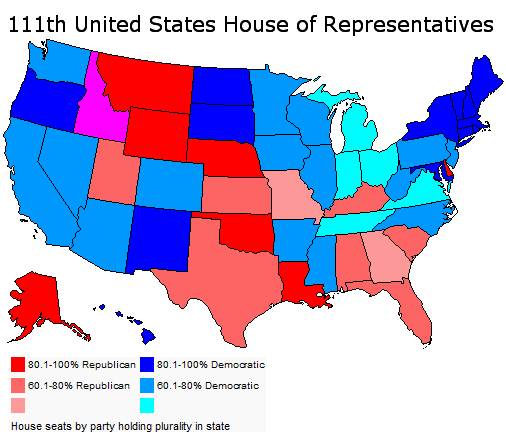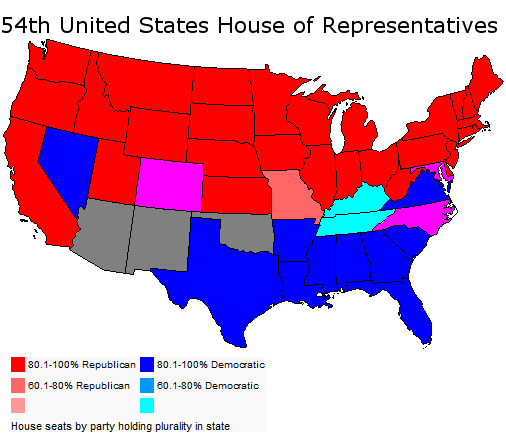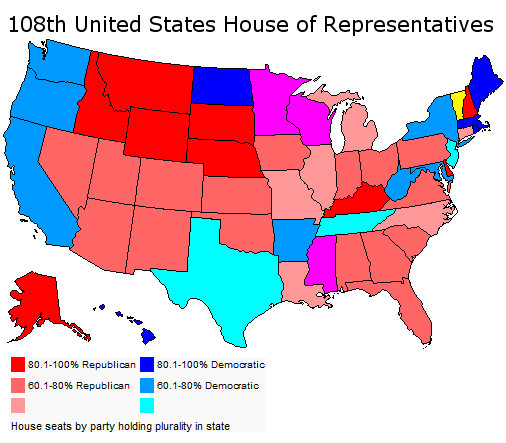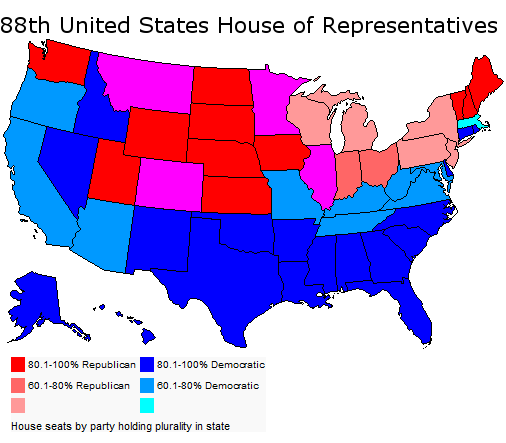In less than 10 months the midterms will be upon us.
In 2006 we fielded candidates in 425 districts and in 2008 candidates in 421.
How will we go in 2010?
Since my last update many more brave Democrats have stepped up to run in Republican held Districts.
AL-05 (Griffith) – R+12,
AL-06 (Bachus) – R+29,
CA-02 (Herger) – R+11,
CA-04 (McClintock) – R+10,
CA-46 (Rohrabacher) – R+6,
CA-49 (Issa) – R+10,
GA-09 (Deal OPEN) – R+28,
IN-04 (Buyer OPEN) – R+14,
IN-06 (Pence) – R+10,
KY-01 (Whitfield) – R+15,
KY-02 (Guthrie) – R+15,
NJ-02 (LoBiondo) – D+1,
NJ-04 (Smith) – R+6,
NJ-07 (Lance) – R+3,
NC-03 (Jones) – R+16,
NC-05 (Foxx) – R+15,
NC-06 (Coble) – R+18,
OH-03 (Turner) – R+5,
OH-04 (Jordan) – R+15,
OH-05 (Latta) – R+9,
OH-07 (Austria) – R+7,
OH-08 (Boehner) – R+11,
OR-02 (Walden) – R+10,
TX-03 (Johnson) – R+14,
TX-04 (Hall) – R+21,
TX-05 (Hensarling) – R+17,
TX-08 (Brady) – R+25,
TX-10 (McCaul) – R+10,
TX-11 (Conaway) – R+28,
TX-12 (Granger) – R+16,
TX-14 (Paul) – R+18,
Below the fold for all the details and hey go check out the 2010 Race Tracker Wiki over at Open Congress for all your House, Senate and Gubernatorial needs.
(Cross posted at Daily Kos, MyDD and Open Left)
Well for starters I think we can safely assume that we will field candidates in all 257 of the Districts that we currently hold.
So onto the Republican held districts:
GOP held Districts have confirmed Democratic Party candidates. This includes in states where candidate filing is still open:
AL-03 (Rogers) – R+9,
AL-05 (Griffith) – R+12,
AL-06 (Bachus) – R+29,
AK-AL (Young) – R+13,
AZ-03 (Shadegg OPEN) – R+9,
AZ-06 (Flake) – R+15,
AR-03 (Boozman OPEN) – R+16,
CA-02 (Herger) – R+11,
CA-03 (Lundgren) – R+6,
CA-04 (McClintock) – R+10,
CA-19 (Radanovich Open) – R+9,
CA-24 (Gallegly) – R+4,
CA-25 (McKeon) – R+6,
CA-26 (Dreier) – R+3,
CA-41 (Lewis) – R+10,
CA-42 (Miller) – R+10,
CA-44 (Calvert) – R+6,
CA-45 (Bono Mack) – R+3,
CA-46 (Rohrabacher) – R+6,
CA-48 (Campbell) – R+6,
CA-49 (Issa) – R+10,
CA-50 (Bilbray) – R+3,
C0-06 (Coffman) – R+8,
DE-AL (Castle OPEN) – D+7,
FL-01 (Miller) – R+21,
FL-05 (Brown-Waite) – R+9,
FL-06 (Stearns) – R+10,
FL-07 (Mica) – R+7,
FL-10 (Young) – R+1,
FL-12 (Putnam OPEN) – R+6,
FL-13 (Buchanan) – R+6,
FL-14 (Mack) – R+11,
FL-15 (Posey) – R+6,
FL-16 (Rooney) – R+5,
FL-21 (Diaz-Balart OPEN) – R+5,
FL-25 (Diaz-Balart OPEN) – R+5,
GA-09 (Deal OPEN) – R+28,
GA-10 (Broun) – R+15,
IA-04 (Latham) – R+0,
IA-05 (King) – R+9,
KS-01 (Moran OPEN) – R+23,
KS-04 (Tiahrt OPEN) – R+14,
LA-02 (Cao) – D+25,
MD-06 (Bartlett) – R+13,
MI-02 (Hoekstra OPEN) – R+7,
MI-11 (McCotter) – R+0,
MN-02 (Kline) – R+4,
MN-03 (Paulsen) – R+0,
MN-06 (Bachmann) – R+7,
MO-08 (Emerson) – R+17,
MT-AL (Rehberg) – R+7,
NV-02 (Heller) – R+5,
NJ-02 (LoBiondo) – D+1,
NJ-04 (Smith) – R+6,
NJ-07 (Lance) – R+3,
OR-02 (Walden) – R+10,
PA-06 (Gerlach) – D+4,
PA-15 (Dent) – D+2,
PA-16 (Pitts) – R+8,
PA-18 (Murphy) – R+6,
PA-19 (Platts) – R+12,
SC-01 (Brown OPEN) – R+10,
SC-02 (Wilson) – R+9,
SC-03 (Barrett OPEN) – R+17,
TN-03 (Wamp OPEN) – R+13,
TN-07 (Blackburn) – R+18,
VA-01 (Wittman) – R+7,
VA-10 (Wolf) – R+2,
WA-04 (Hastings) – R+13,
WA-08 (Reichert) – D+3,
WI-01 (Ryan) – R+2,
WI-05 (Sensenbrenner) – R+12,
Included in this total are 20 GOP held Districts with candidates in states where filing has closed:
IL-06 (Roskam) – R+0,
IL-10 (Kirk OPEN) – D+6,
IL-13 (Biggert) – R+1,
IL-15 (Johnson) – R+6,
IL-16 (Manzullo) – R+2,
IL-18 (Schock) – R+6,
IL-19 (Shimkus) – R+9,
IN-03 (Souder) – R+14,
IN-04 (Buyer OPEN) – R+14,
IN-05 (Burton) – R+17,
IN-06 (Pence) – R+10,
KY-01 (Whitfield) – R+15,
KY-02 (Guthrie) – R+15,
KY-04 (Davis) – R+14,
KY-05 (Rogers) – R+15,
MS-03 (Harper) – R+15,
NE-01 (Fortenberry) – R+11,
NE-02 (Terry) – R+6,
NE-03 (Smith) – R+24,
NC-03 (Jones) – R+16,
NC-05 (Foxx) – R+15,
NC-06 (Coble) – R+18,
NC-09 (Myrick) – R+11,
NC-10 (McHenry) – R+17,
OH-02 (Schmidt) – R+13,
OH-03 (Turner) – R+5,
OH-04 (Jordan) – R+15,
OH-05 (Latta) – R+9,
OH-07 (Austria) – R+7,
OH-08 (Boehner) – R+11,
OH-12 (Tiberi) – D+1,
OH-14 (LaTourette) – R+3,
TX-03 (Johnson) – R+14,
TX-04 (Hall) – R+21,
TX-05 (Hensarling) – R+17,
TX-06 (Barton) – R+15,
TX-08 (Brady) – R+25,
TX-10 (McCaul) – R+10,
TX-11 (Conaway) – R+28,
TX-14 (Paul) – R+18,
TX-19 (Neugebaeur) – R+26,
TX-21 (Smith) – R+14,
TX-22 (Olsen) – R+13,
TX-26 (Burgess) – R+13,
TX-32 (Sessions) – R+8,
WV-02 (Capito) – R+8,
4 GOP held Districts have Democratic Party candidates that are considering a run:
NY-03 (King) – R+4,
WI-06 (Petri) – R+4,
2 GOP held Districts have rumoured Democratic Party candidates:
FL-18 (Ros-Lehtinen) – R+3,
OK-01 (Sullivan) – R+16,
GOP held Districts don’t have any Democratic Party candidates:
AL-01 (Bonner) – R+14,
AL-04 (Aderholt) – R+26,
AZ-02 (Franks) – R+13,
CA-21 (Nunes) – R+13,
CA-22 (McCarthy) – R+16,
CA-40 (Royce) – R+8,
CA-52 (Hunter) – R+9,
C0-05 (Lamborn) – R+14,
FL-04 (Crenshaw) – R+17,
FL-09 (Bilirakis) – R+6,
GA-01 (Kingston) – R+16,
GA-03 (Westmoreland) – R+19,
GA-06 (Price) – R+19,
GA-07 (Linder) – R+16,
GA-11 (Gingrey) – R+20,
ID-02 (Simpson) – R+17,
KS-02 (Jenkins) – R+9,
LA-01 (Scalise) – R+24,
LA-04 (Fleming) – R+11,
LA-05 (Alexander) – R+14,
LA-06 (Cassidy) – R+10,
LA-07 (Boustany) – R+14,
MI-03 (Ehlers OPEN) – R+6,
MI-04 (Camp) – R+3,
MI-06 (Upton) – R+0,
MI-08 (Rogers) – R+2,
MI-10 (Miller) – R+5,
MO-02 (Akin) – R+9,
MO-06 (Graves) – R+7,
MO-07 (Blunt OPEN) – R+15,
MO-09 (Luetkemeyer) – R+9,
NJ-05 (Garrett) – R+7,
NJ-11 (Frelinghuysen) – R+7,
NY-26 (Lee) – R+6,
OK-03 (Lucas) – R+24,
OK-04 (Cole) – R+18,
OK-05 (Fallin OPEN) – R+13,
PA-05 (Thompson) – R+9,
PA-09 (Shuster) – R+17,
SC-04 (Inglis) – R+15,
TN-01 (Roe) – R+21,
TN-02 (Duncan) – R+16,
UT-01 (Bishop) – R+21,
UT-03 (Chaffetz) – R+26,
VA-04 (Forbes) – R+4,
VA-06 (Goodlatte) – R+12,
VA-07 (Cantor) – R+9,
WA-05 (McMorris Rodgers) – R+7,
WY-AL (Lummis) – R+20,
Included in this total are 6 Republican held districts where there is not a Democratic candidate on the ballot as at the closing of candidate filings:
TX-01 (Gohmert) – R+21,
TX-02 (Poe) – R+13,
TX-07 (Culberson) – R+13,
TX-13 (Thornberry) – R+29,
TX-24 (Marchant) – R+11,
TX-31 (Carter) – R+14,
So we now have candidate in House Districts, 4 Districts with candidates considering their options and 2 with rumored candidates.
In this stage in 2007 we had candidates in about 370 Districts but we do now hold 20 more districts. All things considered not a bad position to be in.
Whilst at this stage there is no real cause for concern vis a vis candidate recruitment, so much more remains to be done.
On the upside we already have a full slate in 23 states – Alaska, Arkansas, Connecticut, Delaware, Hawaii, Illinois, Iowa, Kansas, Maine, Maryland, Massachusetts, Minnesota, Mississippi, Montana, Nebraska, Nevada, New Hampshire, New Mexico, North Dakota, Rhode Island, South Dakota, Vermont & West Virginia.
We also have only 1 district to fill in 8 states – Arizona, Colorado, Idaho, Oregon, South Carolina, Washington, Wisconsin and Wyoming.
On the other hand we have Texas where 6 GOP incumbents will be unopposed in November!
Any news, gossip or thoughts in the comments please.






